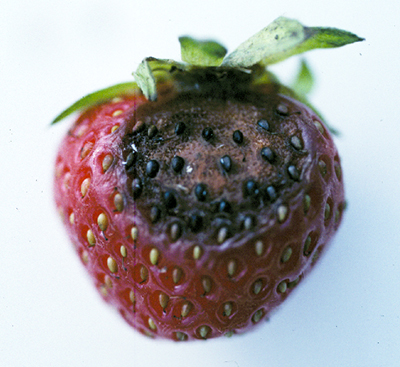Strawberry fruit rots are an inevitable part of growing a perishable fruit like strawberries. Infection usually takes place in the field, but may not manifest itself until after harvest. Warm temperatures, frequent rainfall and high relative humidity contribute to rot development. Even under relatively dry conditions, frequent use of overhead irrigation for watering or cooling the fruit may provide favorable conditions. While Botrytis gray mold is the most well-known and common fruit rot in strawberries, there are other fruit rots that occur in Michigan. Under cool, wet conditions, we may see leather rot (Phytophthora cactorum), whereas warm, humid conditions favor anthracnose fruit rot. In extremely hot weather, Mucor or Rhizopus rot may occur, which causes leaky and “melting” berries.

Early symptoms of anthracnose fruit rot in strawberries.
Anthracnose fruit rot is caused by the fungus Colletotrichum acutatum. Fruit infections are characterized by dark, sunken lesions that may be covered with salmon-pink spore masses. A similar rot caused by Colletotrichum dematium occurs occasionally in Michigan and is characterized by sunken lesions with grayish-white spore masses with black, spiny structures in them. Fruit can be infected at any stage of development, and infected berries eventually shrivel up to become hard, black mummies. Dark brown to black lesions may also be seen on leaf petioles and runners. Under humid conditions, salmon-pink spore masses are visible in these lesions. Spores are dispersed by rain or irrigation water splash and can land several feet from an infection source. The fungus can reproduce on leaves without symptoms, which may result in apparent rapid spread of the disease. Anthracnose fruit rot is favored by hot, humid weather and frequent rain or overhead irrigation. The optimum temperature for disease development is 80 degrees Fahrenheit and at least six hours of wetting is required for infection. The longer the fruit remains wet, the greater the risk of infection.

Late symptoms of anthracnose fruit rot in strawberries.
The fungus can be brought in on planting material and overwinters in mummified fruit and infected plant debris in the field. In the spring, spore dispersal from old infected tissues occurs with rain. Disease pressure is higher in strawberries grown on plastic-mulched beds due to more water splash and pooling on the plastic. In addition, fields without straw mulch between the rows tend to have more disease than fields with good straw cover, presumably due to a reduction in rainsplash and wetting of berries. The fungus can also spread by pickers or equipment touching infected berries with spores on them. Most strawberry cultivars grown in the Midwest are susceptible to anthracnose fruit rot. Certain ever-bearing strawberry cultivars are very susceptible, including Camarosa and Seascape. Growing these under a plastic roof or tunnel can virtually eliminate anthracnose fruit rot problems.
Managing anthracnose fruit rot
A good place to start is to buy disease-free transplants from a reputable nursery. Do not use plastic mulch and maintain straw mulch between the rows. Grow susceptible ever-bearing strawberries under plastic. Reduce leaf wetness by avoiding dense canopies that could be caused by over-fertilization. Use drip irrigation or time overhead irrigation to overlap with natural dew periods. Monitor fields regularly for disease symptoms. Early season fruit with infections should be culled and removed from the field. During a disease outbreak, pick or cultivate diseased fields last and train pickers to avoid diseased fruit. Do not move equipment or walk through field when plants are wet. Cool fruit rapidly after harvest. During renovation, remove and burn or bury crop debris, including old mummies.
Preventive fungicide applications may be needed from flower bud emergence to harvest. Fungicides work best when applied before infection, and should be applied before extended rainy periods. Systemic fungicides may have limited curative activity. The most effective fungicides listed for anthracnose fruit rot are: Pristine, Cabrio, Abound, Quadris Top and Quilt Excel. Other fungicides with good efficacy are: Captevate, Thiram, Inspire Super and Topsin M plus Captan. Captan by itself has moderate efficacy. Due to the risk of fungicide resistance, fungicides with different modes of action should be alternated, and it may be helpful to tank-mix Captan with a systemic fungicide during periods of high disease pressure. For details, consult the “Michigan Fruit Management Guide” (E0154) by Michigan State University Extension.
Strawberry fruit rots are an inevitable part of growing a perishable fruit like strawberries. Infection usually takes place in the field, but may not manifest itself until after harvest. Warm temperatures, frequent rainfall and high relative humidity contribute to rot development. Even under relatively dry conditions, frequent use of overhead irrigation for watering or cooling the fruit may provide favorable conditions. While Botrytis gray mold is the most well-known and common fruit rot in strawberries, there are other fruit rots that occur in Michigan. Under cool, wet conditions, we may see leather rot (Phytophthora cactorum), whereas warm, humid conditions favor anthracnose fruit rot. In extremely hot weather, Mucor or Rhizopus rot may occur, which causes leaky and “melting” berries.